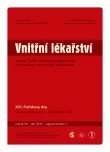The out- patient with a newly diagnosed thrombocytopenia
Published in:
Vnitř Lék 2010; 56(Supplementum 1): 10-13
Category:
16th Parizek's Days, Ostrava-Poruba, March 25th –26th 2010
Overview
Most cases of thrombocytopenia are discovered incidentally in patients with various health problems, which have no bleeding symptoms. Most of them are inconsequential; however, sometimes thrombocytopenia is the first symptom of a serious or life - threatening disease. After the exclusion of pseudo thrombocytopenia, the attention should be focused on the most serious diagnoses, especially on disseminated intravascular coagulation, thrombotic microangiopathy, acute leukemias or heparin induced thrombocytopenia. These disorders should be diagnosed as soon as possible, because the early start of treatment is crucial to patient’s survival. After these diseases are excluded, the process of differential diagnosis continues, including thorough assessment of history, physical examination and numerous laboratory tests, because a large number of disorders accompanied by thrombocytopenia exist.
Key words:
thrombocytopenia – pseudo thrombocytopenia – differential diagnosis
Sources
1. Rodeghiero F, Stasi R, Gernsheimer T et al. Standardization of terminology, definitions and outcome criteria in immune thrombocytopenic purpura of adults and children: report from an international working group. Blood 2009; 113 : 2386 – 2393.
2. García Suárez J, Merino JL, Rodríguez M et al. Pseudothrombocytopenia: incidence, causes and methods of detection. Sangre (Barc) 1991; 36 : 197 – 200.
3. Mant MJ, Doery JC, Gauldie J et al. Pseudothrombocytopenia due to platelet aggregation and degranulation in blood collected in EDTA. Scand J Haematol 1975; 15 : 161 – 170.
4. Peters M, Heyderman RS, Klein NJ Platelet satellitism. N Engl J Med 1998; 339 : 131 – 132.
5. Veneri D, Franchini M, Randon F et al. Thrombocytopenias: a clinical point of view. Blood Transfus 2009; 7 : 75 – 85.
6. Cohen YC, Djulbegovic B, Shamai ‑ Lubovitz O et al. The bleeding risk and natural history of idiopathic thrombocytopenic purpura in patients with persistent low platelet counts. Arch Intern Med 2000; 160 : 1630 – 1638.
7. Avvisati G, Tirindelli MC, Annibali O. Thrombocytopenia and hemorrhagic risk in cancer patients. Crit Rev Oncol Hematol 2003; 48 (Suppl): S13 – S16.
8. Webert K, Cook RJ, Sigouin CS et al. The risk of bleeding in thrombocytopenic patients with acute myeloid leukemia. Haematologica 2006; 91 : 1530 – 1537.
9. Slichter SJ. Relationship between platelet count and bleeding risk in thrombocytopenic patients. Transfus Med Rev 2004; 18 : 153 – 167.
10. Rebulla P. Platelet transfusion trigger in difficult patients. Transfus Clin Biol 2001; 8 : 249 – 254.
11. Letsky EA, Greaves M. Guidelines on the investigation and management of thrombocytopenia in pregnancy and neonatal alloimmune thrombocytopenia. Maternal and Neonatal Haemostasis Working Party of the Haemostasis and Thrombosis Task Force of the British Society for Haematology. Br J Haematol 1996; 95 : 21 – 26.
12. Kitchens CS. Thrombocytopenia and thrombosis in disseminated intravascular coagulation (DIC). Hematology 2009; 9 : 240 – 246.
13. Moake J. Thrombotic thrombocytopenia purpura (TTP) and other thrombotic microangiopathies. Best Pract Res Clin Haematol 2009; 22 : 567 – 576.
14. Burns ER, Lou Y, Pathak A. Morphologic diagnosis of thrombotic thrombocytopenic purpura. Am J Hematol 2004; 75 : 18 – 21.
15. Saigo K, Jiang M, Tanaka C et al. Usefulness of automatic detection of fragmented red cells using a hematology analyzer for diagnosis of thrombotic microangiopathy. Clin Lab Haematol 2002; 24 : 347 – 351.
16. Tsai HM. Thrombotic thrombocytopenic purpura: a thrombotic disorder caused by ADAMTS13 deficiency. Hematol Oncol Clin North Am 2007; 21 : 609 – 632.
17. Kořístek Z, Žák P. Koagulopatie a diferenciační syndrom: hlavní komplikace úvodní léčby akutní promyelocytární leukemie. Vnitř Lék 2008; 54 : 745 – 750.
18. Warkentin TE. Think of HIT. Hematology 2006; 6 : 408 – 414.
19. Martel N, Lee J, Wells PS. Risk for heparin‑induced thrombocytopenia with unfractionated and low ‑ molecular ‑ weight heparin thromboprophylaxis: a meta‑analysis. Blood 2005; 106 : 2710 – 2715.
20. Warkentin TE, Sheppard JA, Sigouin CS et al. Gender imbalance and risk factor interactions in heparin‑induced thrombocytopenia. Blood 2006; 108 : 2937 – 2941.
21. Lubenow N, Kempf R, Eichner A et al. Heparin‑Induced Thrombocytopenia: temporal pattern of thrombocytopenia in relation to initial use or re‑exposure to heparin. Chest 2002; 122 : 37 – 42.
22. Warkentin T, Kelton J. Delayed ‑ onset heparin‑induced thrombocytopenia and thrombosis. Ann Intern Med 2001; 135 : 502 – 506.
23. Warkentin TE New approaches to the diagnosis of heparin‑induced thrombocytopenia. Chest 2005; 127 (2 Suppl): 35S – 45S.
24. Ortel TL. Heparin‑induced thrombocytopenia: when a low platelet count is a mandate for anticoagulation. Hematology Am Soc Hematol Educ Program 2009 : 225 – 232.
25. Othman M, Favaloro EJ. Genetics of type 2B von Willebrand disease: “true 2B”, “tricky 2B”, or “not 2B”. What are the modifiers of the phenotype? Semin Thromb Hemost 2008; 34 : 520 – 531.
26. Galbusera M, Noris M, Remuzzi G. Inherited thrombotic thrombocytopenic purpura. Haematologica 2009; 94 : 166 – 170.
Labels
Diabetology Endocrinology Internal medicineArticle was published in
Internal Medicine

2010 Issue Supplementum 1
Most read in this issue
- Thrombocytopenia and coagulopathy in hepatopathy: an introduction into the issue
- Monitoring of coagulation parameters and options to influence them in patients with liver cirrhosis prior to invasive procedures
- Differential diagnosis of thrombocytopaenia in pregnancy
- The application of IPF (Immature platelet fraction) in laboratory diagnostics
